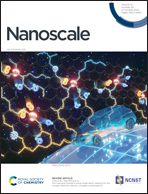Electromagnetic absorption enhancing mechanisms by modified biochar derived from Enteromorpha prolifera: a combined experimental and simulation study†
Abstract
Although the rapid advances of wireless technologies and electronic devices largely improve the quality of life, electromagnetic (EM) pollution increases the risk of exposure to EM radiation. Developing high-efficiency absorbers with a rational structure and wideband characteristics is of great significance to eliminate radiation pollution. Herein, Enteromorpha prolifera derived biochar which would provide a suitable surface and multiple polarizations has been prepared as the supporter to anchor nanoparticles. In addition, theoretical simulation results further confirm that radar wave scattering could be largely inhibited after coating with absorbing materials. As a result, the hybrid absorbers achieve remarkable EM absorption properties attributed to the synergistic magnetic–dielectric loss. Elaborate compositional and structural characterization studies indicate that the absorber has a large specific area and numerous polarization centers, which would make full use of waste biomass as light weight and broadband high-performance EM absorption materials.

- This article is part of the themed collection: 2022 Nanoscale HOT Article Collection


 Please wait while we load your content...
Please wait while we load your content...